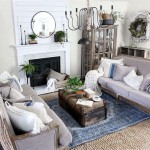Minimalist Home Decor Ideas: Cultivating Calm Through Simplicity
Minimalist home decor is a design philosophy centered around simplicity, functionality, and the mindful selection of objects. It's not about stark emptiness, but rather about creating a serene and uncluttered environment that promotes well-being and a sense of calm. This approach emphasizes quality over quantity, focusing on items that are both beautiful and purposeful. Implementing minimalist principles can transform a house into a haven, free from the distractions of excessive possessions and promoting a more intentional way of living.
The appeal of minimalist design lies in its ability to create a space that feels open, airy, and visually appealing. It prioritizes natural light, neutral color palettes, and clean lines, fostering a sense of tranquility. By reducing visual clutter, minimalist decor allows the eye to rest and the mind to relax. This philosophy extends beyond aesthetics, encouraging a more conscious approach to consumption and a deeper appreciation for the things that truly matter.
Embracing Neutral Color Palettes and Natural Light
A cornerstone of minimalist design is the strategic use of neutral color palettes. Colors such as white, beige, gray, and soft earth tones form the foundation of a minimalist space. These colors create a sense of spaciousness and serenity, reflecting light and making rooms feel larger and more open. While neutral colors dominate, subtle pops of muted color, such as dusty blues or greens, can be incorporated to prevent the space from feeling sterile or monotonous. The key is to use these accent colors sparingly and with intention.
The interplay of light and shadow is also a crucial element in minimalist design. Maximizing natural light is essential for creating a bright and inviting atmosphere. Windows should be kept clear of heavy drapes or excessive ornamentation, allowing sunlight to flood the room. When natural light is limited, strategically placed artificial lighting can be used to mimic its effects. Recessed lighting, simple floor lamps, and strategically placed task lighting can enhance the ambiance without adding visual clutter. The goal is to create a layered lighting scheme that is both functional and aesthetically pleasing.
Furthermore, the textures within a minimalist space contribute significantly to its overall appeal. While the color palette may be restrained, incorporating a variety of textures adds depth and visual interest. Natural materials such as wood, linen, cotton, and stone can be used to create a tactile experience that is both comforting and sophisticated. A wool throw blanket, a linen cushion, or a woven basket can add warmth and character to a minimalist space, preventing it from feeling cold or impersonal.
Prioritizing Functional Furniture and Decluttered Surfaces
Furniture in a minimalist home is carefully selected for its functionality and design. Each piece should serve a specific purpose and contribute to the overall aesthetic of the space. Multifunctional furniture is particularly valuable in minimalist design, as it helps to maximize space and minimize clutter. A sofa bed, a storage ottoman, or a nesting table can provide extra functionality without taking up extra floor space. The focus should be on investing in a few high-quality pieces that are both durable and aesthetically pleasing, rather than filling the space with cheap or unnecessary items.
Decluttered surfaces are another defining characteristic of minimalist home decor. Countertops, tables, and shelves should be kept clear of unnecessary items, allowing the eye to focus on the inherent beauty of the space. Small decorative objects, such as vases, sculptures, or plants, can be used sparingly to add personality and visual interest, but the overall emphasis should be on simplicity and order. Implementing storage solutions such as built-in shelves, concealed cabinets, and decorative baskets helps to keep clutter out of sight and maintain a sense of calm and order.
The arrangement of furniture in a minimalist space is also important. Furniture should be arranged in a way that promotes flow and enhances the functionality of the room. Avoid overcrowding furniture, and instead, leave plenty of open space for movement and circulation. Consider the natural traffic patterns in the room and arrange furniture accordingly. The goal is to create a space that is both visually appealing and comfortable to live in.
Selecting Meaningful Decor and Embracing Negative Space
Minimalist decor is not about eliminating all decorative items but rather about carefully selecting a few meaningful pieces that reflect personal style and values. These items might include artwork, photographs, books, or souvenirs from travels. The key is to choose items that evoke positive emotions and contribute to the overall ambiance of the space. Avoid cluttering surfaces with meaningless trinkets or dust-collecting items. Each object should be chosen with intention and should have a specific purpose or sentimental value.
Artwork can play a significant role in minimalist home decor, adding personality and visual interest to a space. Choose artwork that complements the overall color palette and style of the room. Large-scale abstract paintings, black and white photography, or simple line drawings can be particularly effective in minimalist spaces. When hanging artwork, keep the arrangement simple and uncluttered. Avoid overcrowding walls with too many pieces, and instead, focus on highlighting individual works of art.
Embracing negative space is a key element of minimalist design. Negative space refers to the empty areas around and between objects. It creates a sense of balance and allows the eye to rest. In a minimalist home, negative space is just as important as the objects themselves. It allows each item to breathe and prevents the space from feeling cluttered or overwhelming. By strategically incorporating negative space, the minimalist home achieves a sense of calm and serenity.
Plants are an excellent way to add life and vibrancy to a minimalist space. Greenery brings a touch of nature indoors, purifying the air and creating a sense of well-being. Choose plants that are easy to care for and that complement the overall aesthetic of the room. Succulents, snake plants, and peace lilies are popular choices for minimalist homes. Place plants strategically throughout the space, ensuring that they receive adequate light and water. The presence of plants can transform a minimalist space from sterile to welcoming.
Ultimately, minimalist home decor is about creating a space that reflects personal values and promotes a more intentional way of living. By embracing simplicity, functionality, and mindfulness, it is possible to transform any house into a sanctuary of calm and serenity. The principles discussed above serve as a foundation for building a minimalist environment, but the true essence of minimalism lies in its adaptable nature, allowing homeowners to blend it with their personal preferences and needs.
:strip_icc()/af1be3_3075c14ccd2b461aaa9f8b3bc4e1c5e3_mv2-56f748ca98b44c8b861fa0a01d5bc504.jpeg?strip=all)
8 Ways To Embrace Minimalist Interior Design At Home

9 Ways To Minimalist Decor That Will Make Your Home Clutter Free

19 Minimalist Design Ideas For A Stylish Clutter Free Home Extra Space Storage
:max_bytes(150000):strip_icc()/ScreenShot2022-12-14at2.46.36PM-bb837b67e0884152959f525b6e426c67.png?strip=all)
25 Minimalist Decorating Ideas For A Calm And Clean Space

11 Minimalistic White Design Ideas For Your Home Cafe

11 Minimalist Home Design Tips And Ideas Designcafe

30 Minimalist Living Room Ideas

19 Minimalist Design Ideas For A Stylish Clutter Free Home Extra Space Storage

30 Minimalist Living Rooms Furniture Ideas For

Minimalist Decor Ideas To Make Your Home Look Elegant Interior Living Room Design







